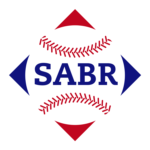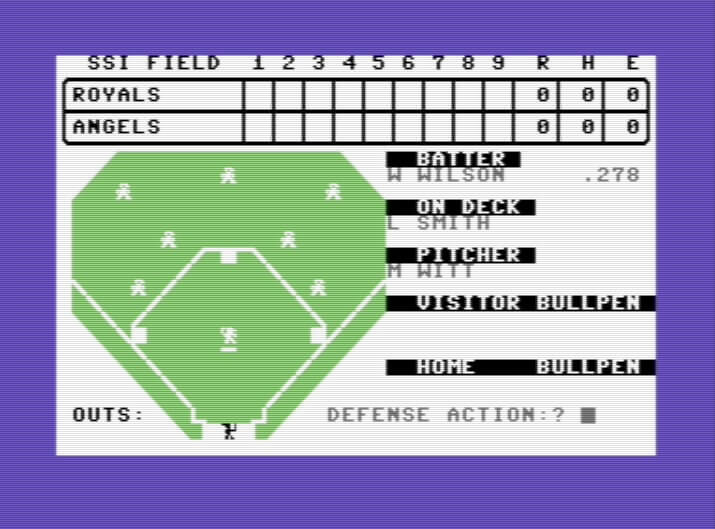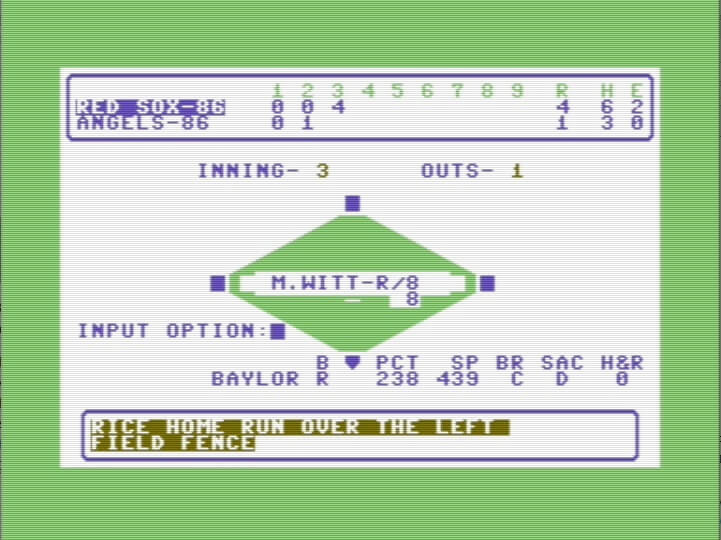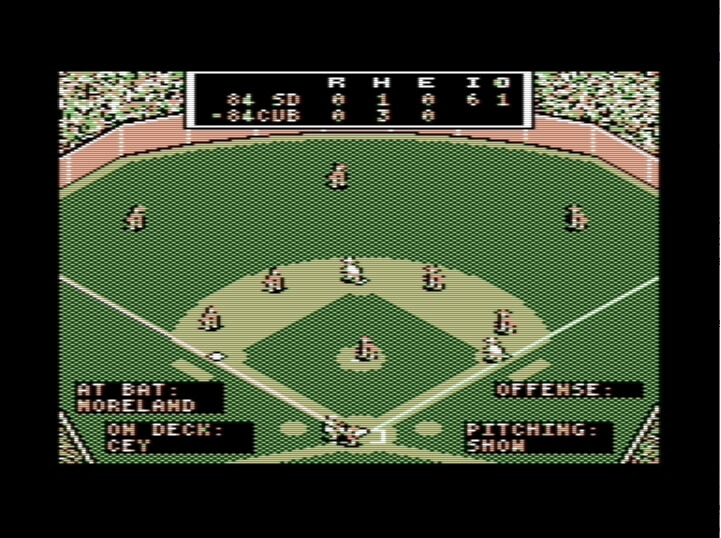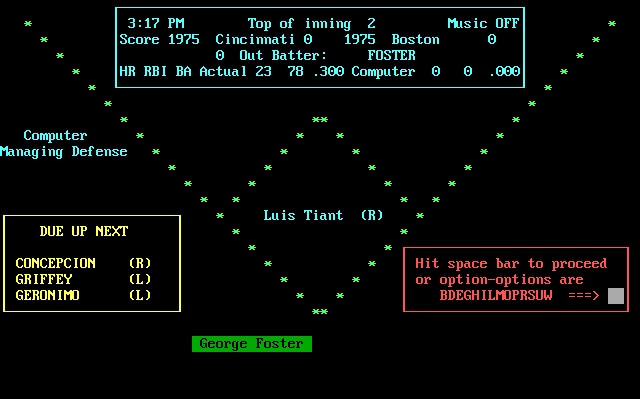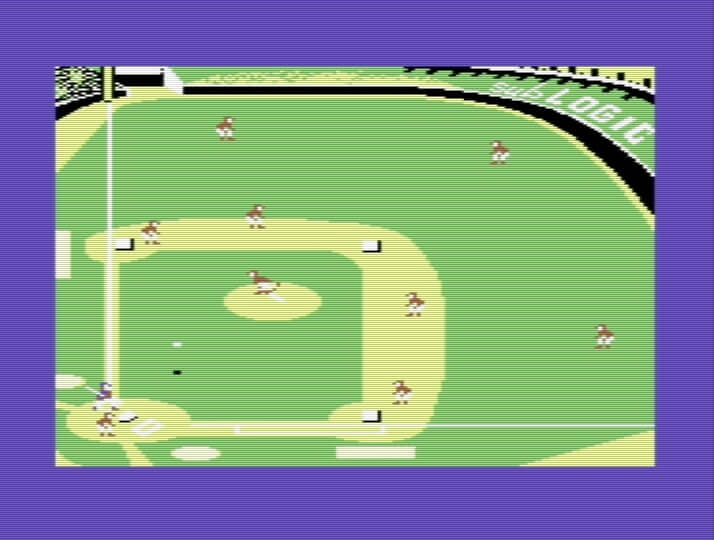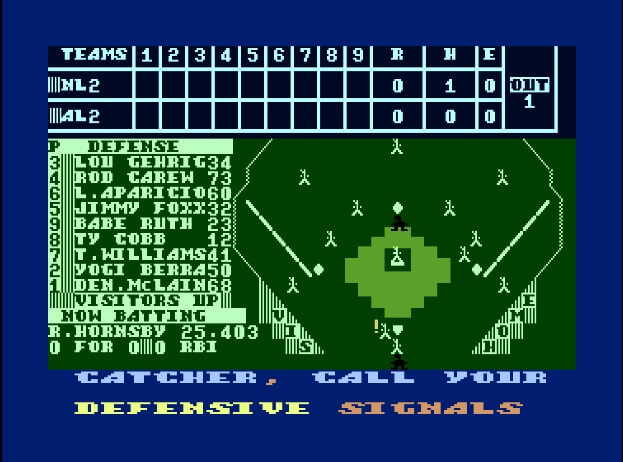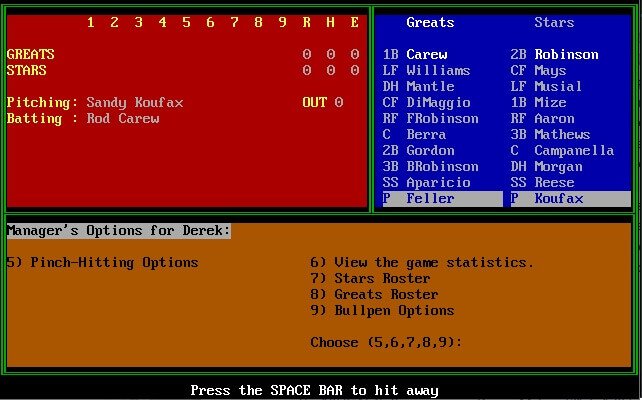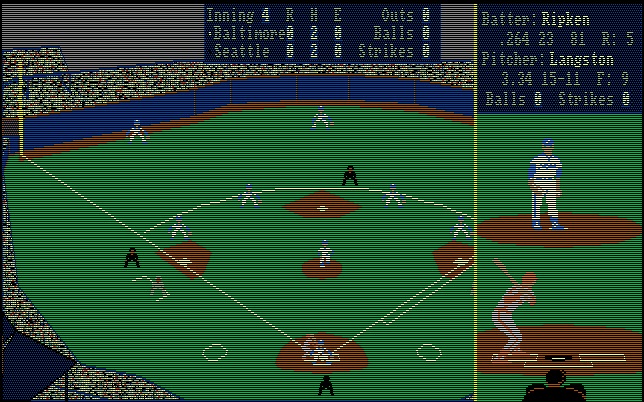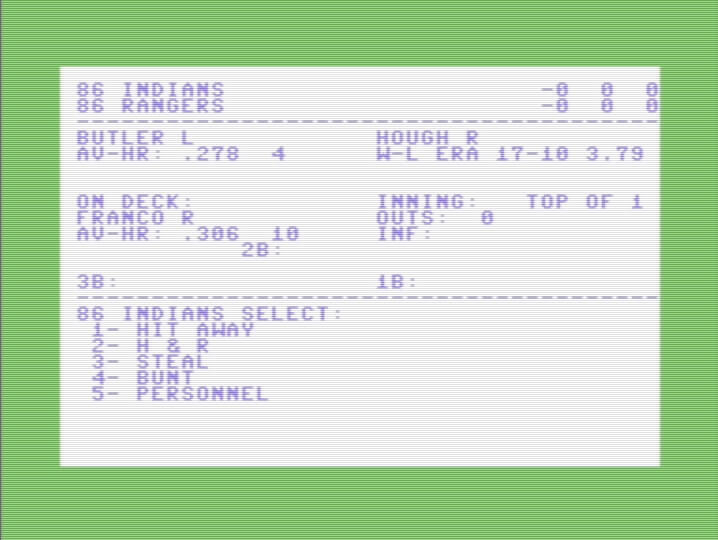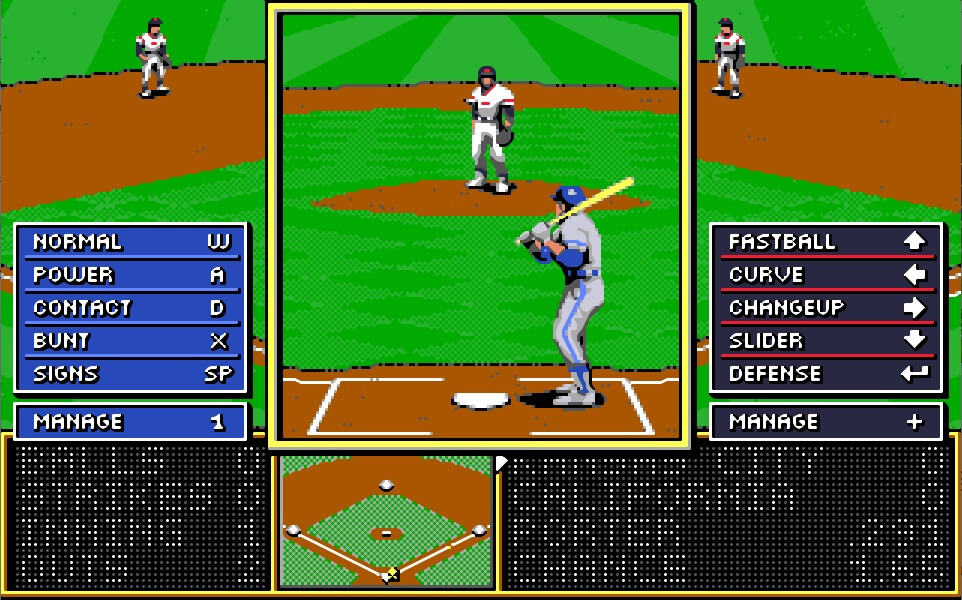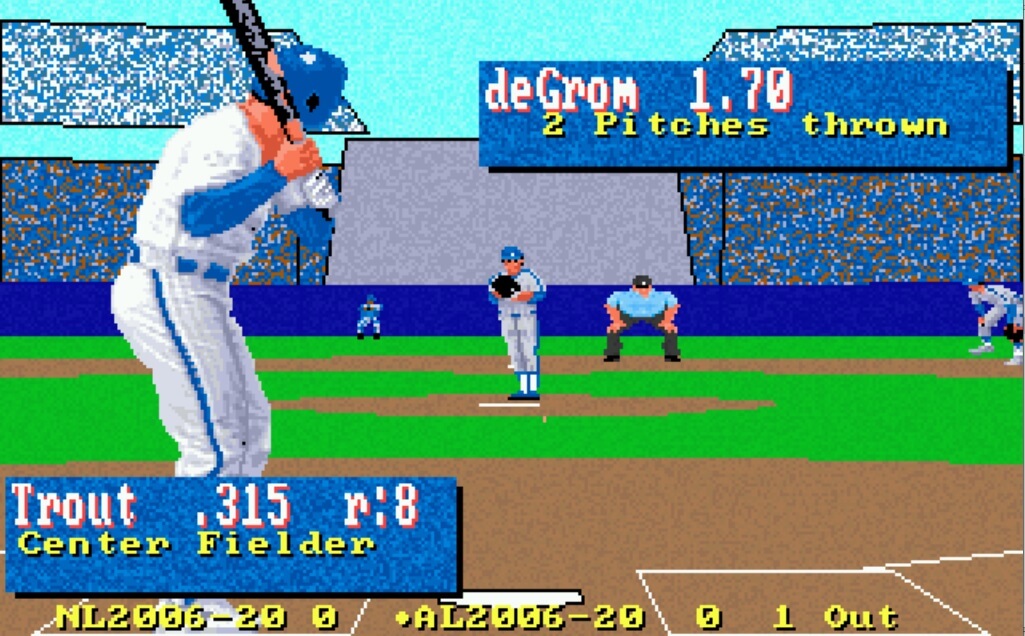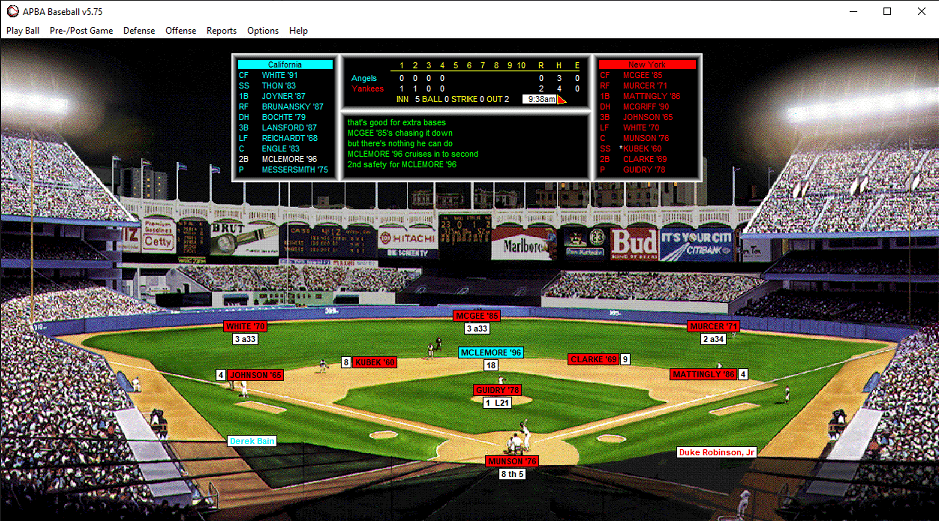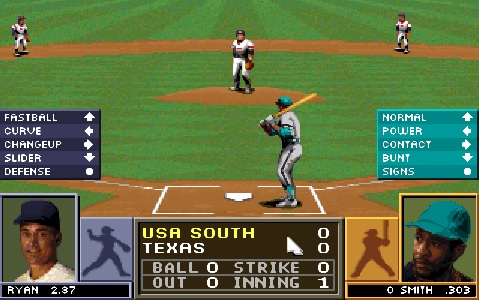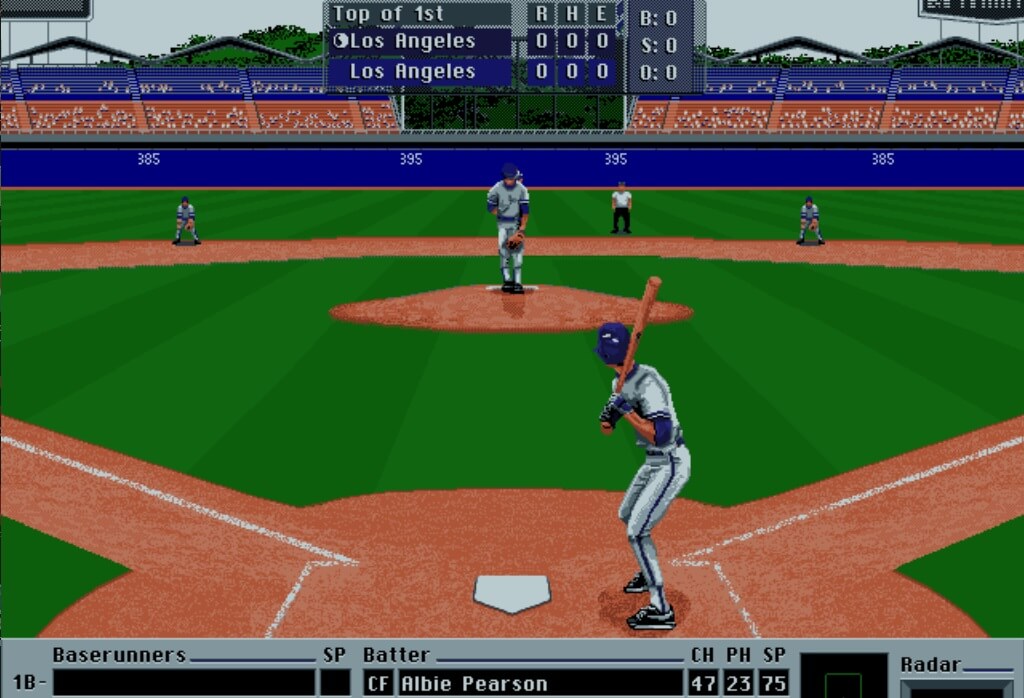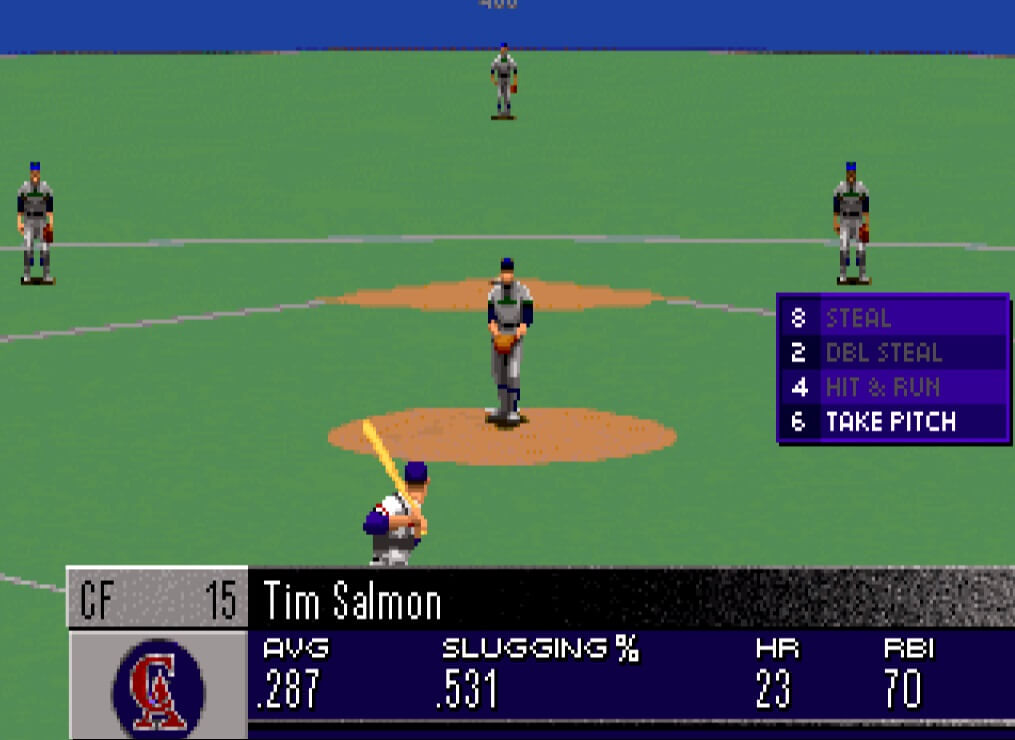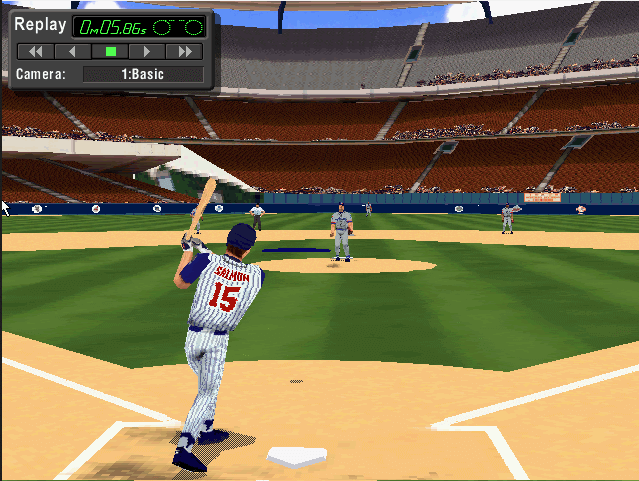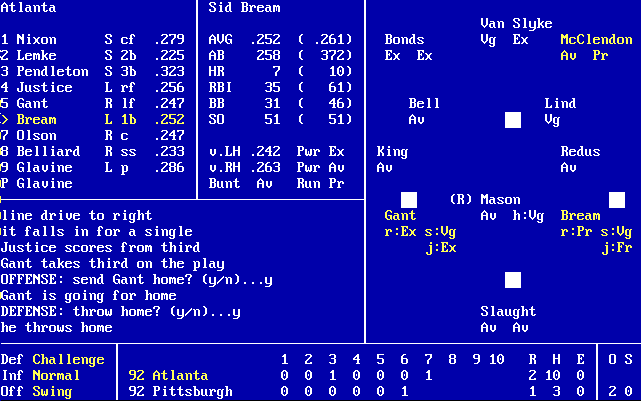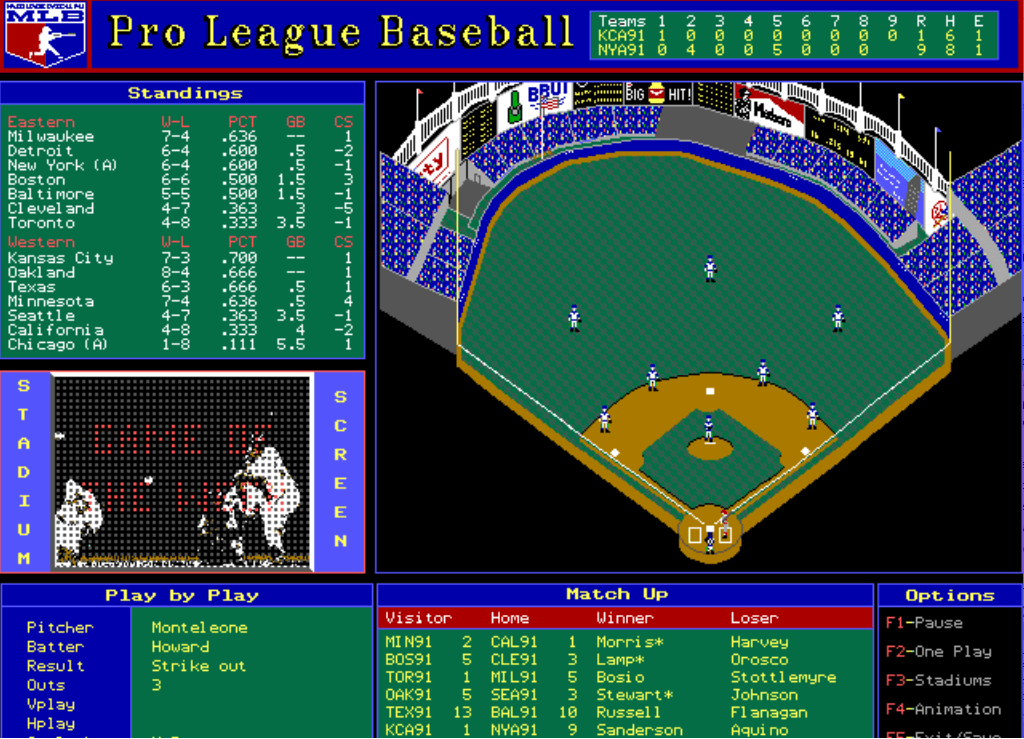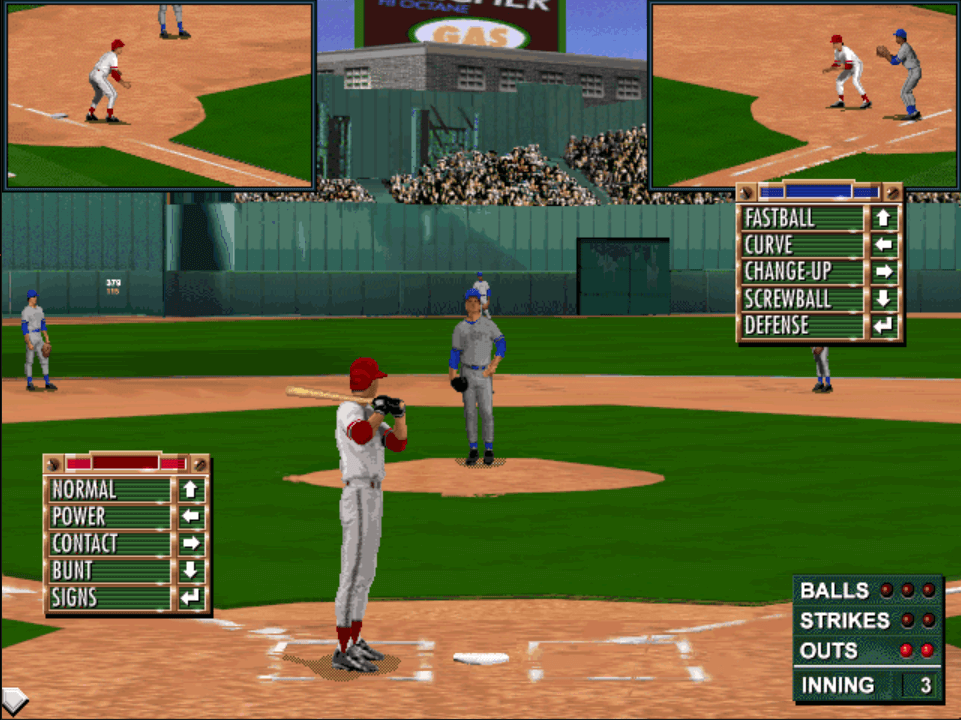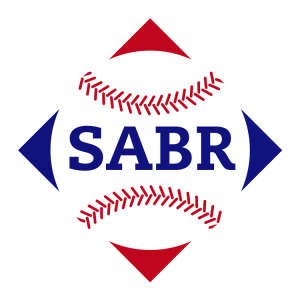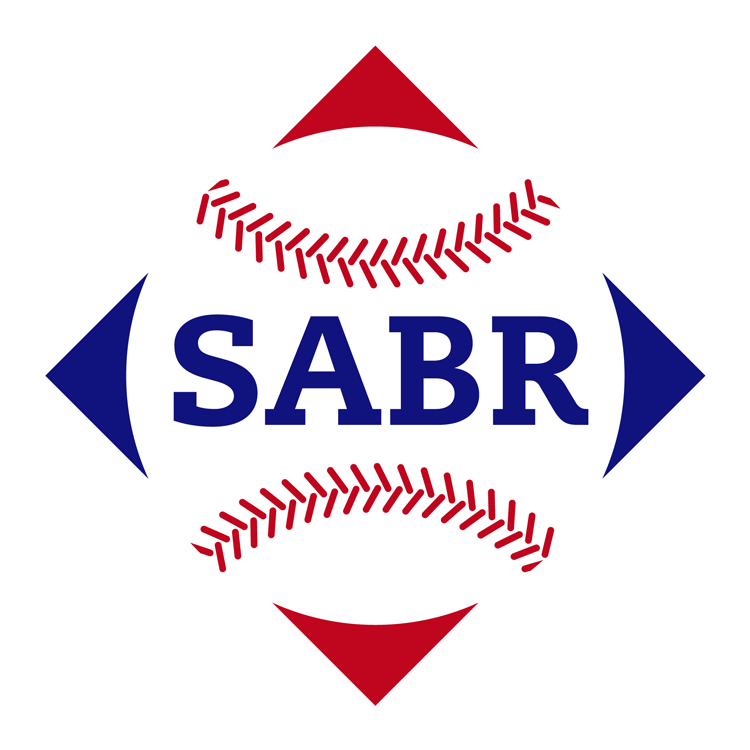This is the tenth entry in a series focusing on computer baseball simulations to supplement the chapter “Play Retro Baseball Video Games In Your Browser” from my Hardball Retroactive book along with the corresponding post at Hardball Retro. The series focuses on baseball simulations – games in which the primary emphasis is on managerial strategy and the ability to replay entire seasons with a degree of realism. Baseball video games that are strictly arcade representations of baseball (based solely on reflex and hand-eye coordination) are excluded.
MicroLeague Baseball II (Atari ST edition):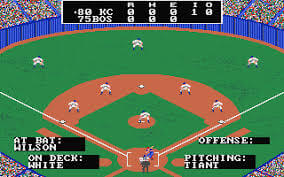
MicroLeague Baseball II (Enhanced) for Commodore 64: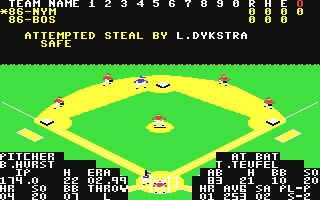
MicroLeague Baseball: The Manager’s Challenge (IBM PC edition):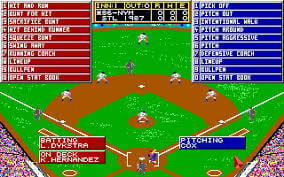
MicroLeague Baseball IV (IBM PC edition):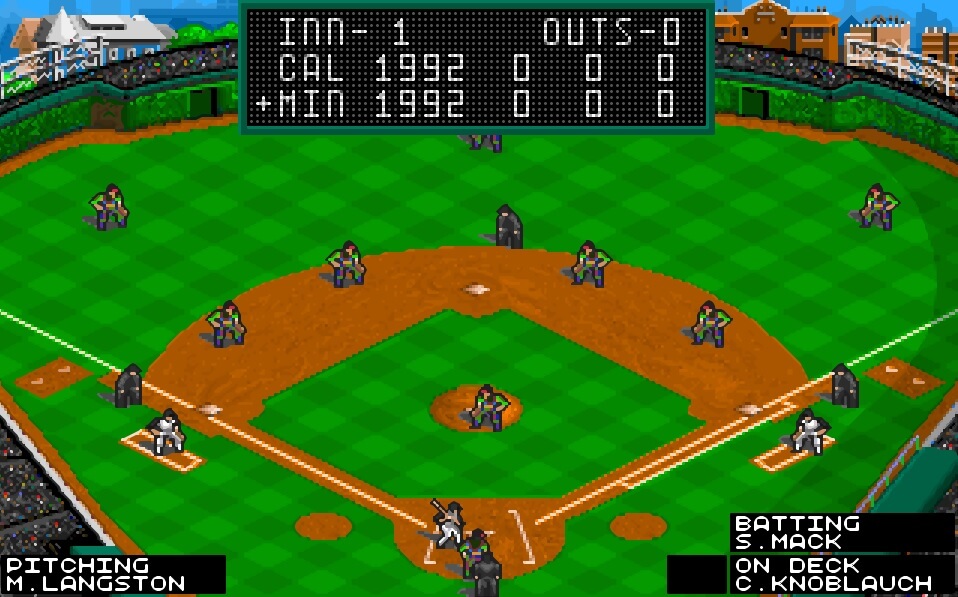
Publisher – MicroLeague Sports Association
Release Year – MicroLeague Baseball II – 1989 (Atari ST/IBM PC/Macintosh), 1990 (C64)
MicroLeague Baseball: The Manager’s Challenge – 1991
MicroLeague Baseball IV – 1992
Platforms –MicroLeague Baseball II Atari ST, Commodore 64, IBM PC, Macintosh
MicroLeague Baseball: The Manager’s Challenge IBM PC
MicroLeague Baseball IV IBM PC
Credits
MicroLeague Baseball II
| Game Design: | Barry R. Morstain, Subway Software Group, Mark J. Trigsted |
| Game Design (Commodore 64): | P.S. Consulting and Subway Software |
| Programming: | James A. Dorsman, Douglas E. Mackall, |
| Programming (Macintosh): | Adventure Architects, Lon Hildreth, Walter Hunt |
| Programming Coordinator (Mac): | Mark Lesser |
| Programming (Commodore 64): | P.S. Consulting |
| Graphics & Animation (Mac): | George Karalias |
| Art Design: | Curt Simmons Wayne |
MicroLeague Baseball IV
| Programming: | Jim Nangano, Ed Daniels, Skip Haughay |
| Graphic Artist: | Steve Suhy |
| Music and Sound: | The Fat Man, David Govett |
| Additional Music / Sound Effects: | Rob Wallace |
Review
This is a combined review for MicroLeague Baseball II, MicroLeague Baseball: The Manager’s Challenge and MicroLeague Baseball IV. I decided to merge the 3 releases into a single review based on the following observations:
- MicroLeague Baseball II failed to offer a significant upgrade over the original version.
- The Commodore 64 release (MicroLeague Baseball II “Enhanced”) essentially represents an entirely different product (Pure-Stat Baseball) repackaged as MicroLeague Baseball. The relatively few “enhancements” in this version do not warrant a separate review.
- MicroLeague Baseball: The Manager’s Challenge and MicroLeague Baseball IV introduce several new features while retaining much of the original’s charm.
Therefore I resolved to concentrate my efforts on a review of MicroLeague Baseball IV while noting the differences between the second and third editions of the game along the way. I launched DosBox and fired up MLBB IV. The main menu facilitates a multitude of functions. Note that the General Manager / Owner option can only be executed if you installed the GM/Owner add-on disk (sold separately).
I generated a schedule to replay the 1992 season using the Schedule Editor then selected League Play. You have the ability to quick-play a single day, week or entire season with a single click. My entire replay of the regular season took less than 7 minutes to complete. The virtual ’92 Mets outpaced their real-life counterparts by 20 games to claim the NL East by a 4-game margin over the actual division-winning Pirates. The Braves secured the NL West in both realms, albeit by the slimmest of margins in the MicroLeague replay. The American League simulation featured tight races with the Orioles edging the Brewers in the East and the White Sox tiptoeing past the Twins in the West. Oakland fared the worst among actual division champs in the simulation as the club posted a 77-85 mark, 19 games below their real victory total.
A quick glance at the compiled statistics reveals an issue with the lineup selection, fatigue/usage factors and in-game AI. With the American League lineups in particular, the bench is hardly utilized and in some cases, the “starting 9” played the entire season without any rest. Perhaps due to faulty stamina ratings, I noted a number of starting pitchers with 30+ starts and less than 50 innings pitched. Consequently one or more relievers were saddled with an extremely unrealistic workload. Jeff Johnson (Yankees) yielded a 6.62 ERA in a preposterous 410 innings of work! Milwaukee portsider Bruce Ruffin’s 30-10 record in 99 appearances defies logic. Rod Nichols crafted a 28-9 record with a 3.15 ERA in 394 relief innings for the Tribe. Dave Righetti prevailed in 19 of 21 decisions out of the Giants’ bullpen. Red Sox southpaw Tom Bolton delivered a 21-15 mark in 71 outings. Several teams only utilized 3 relievers for the entire year. Other long relief aces included Mike Flanagan (20-5, 5.26 for the O’s) and Bob Kipper (24-11, 4.09 for the Twins).
The game does not include an option to view leader boards so the user must tab through individual team statistics. I did not perform an exhaustive search but observed a record-breaking 74 home runs by Indians first baseman Paul Sorrento! Juan Guzman notched 21 wins for the Jays.
I quick-played a series of exhibition games to determine the American and National League champions. Atlanta advanced to the World Series with a convincing sweep of the Metropolitans in the NLCS. Terry Pendleton swatted big-flies in the second and fourth contest while Tom Glavine twirled a three-hitter in Game 2. Mike Devereaux clubbed 3 circuit clouts and knocked in 5 runs in an 11-2 rout by the O’s in the initial matchup. Cal Ripken Jr. went yard in each of the next 3 contests and Devereaux added a round-tripper in Game 3 to punch Baltimore’s ticket to the Series as they took the Pale Hose to the cleaners with a sweep of the ALCS.
I elected to manage the Braves as the Series opened at Atlanta-Fulton County Stadium. John Smoltz took the ball in Game 1 while the O’s countered with Mike Mussina. After a pair of scoreless innings from both aces, Randy Milligan lashed a 2-run single up the middle to score Mike Devereaux and Cal Ripken Jr. In the fourth frame, Devereaux socked a 3-run blast into the left field bleachers to extend Baltimore’s lead to 5-0. Smoltz broke up Mussina’s no-hitter with 2 outs in the sixth with a clean opposite field single to right field. Ripken belted a big-fly to center off “Smoltzie” to put the O’s ahead 6-0. Juan Berenguer and Marvin Freeman put up goose eggs for the remainder of the game. Mussina cruised to a one-hit shutout, retiring Terry Pendleton on a lazy fly ball to left to close out the contest.
Tom Glavine got the nod in Game 2, squaring off against Bob Milacki. Cal Ripken Jr. socked a 2-run homer in the top of the first to put Baltimore ahead. In the bottom of the frame, Terry Pendleton rapped a long double to right-center and scored on a two-out base knock to right by Sid Bream. Both pitchers settled in and pitched scoreless ball for a few innings. The Braves knotted the game at 2-2 when Bream trudged home on a fielder’s choice in the fourth. Mike Flanagan replaced Milacki on the bump after Bream led off the bottom of the sixth with a sharp liner over Ripken’s head. Glavine laced a single to right with two away. O’s right fielder David Segui gunned down Mark Lemke at third base, but not before Bream crossed home plate with the go-ahead run. Pendleton extended the Atlanta lead with an opposite-field four-bagger in the seventh inning. Glavine got the hook after issuing consecutive free passes to Ripken and Glenn Davis in the eighth, followed by a two-out single by Chris Hoiles to close the gap to 4-3. Alejandro Pena fanned Segui to extinguish the threat. Baltimore brought their third pitcher into the contest after Brian R. Hunter delivered a pinch-hit line drive to left to open the bottom of the eighth. Todd Frohwirth induced Deion Sanders to rap into a 1-4-3 double play. Pena closed out the game with a clean inning, although Otis Nixon had to range into the left field corner to flag down Brady Anderson’s drive for the final out.
The teams headed to Baltimore for Game 3 with the Series tied. Ben McDonald got the starting assignment in the first World Series tilt at Camden Yards while the visitors countered with southpaw Steve Avery. Brady Anderson belted a long ball over the wall in right-center leading off the bottom of the first. Later in the same inning, Mike Devereaux came around on a hot grounder up the middle off the bat of Randy Milligan. Atlanta failed to answer until the fifth when Sid Bream’s line drive cleared the scoreboard in right. The Orioles knocked Avery from the contest in the seventh frame as they tacked on a pair of insurance runs. Atlanta brought the tying run to the plate in the top of the eighth. Following a two-out double by Ron Gant, the O’s elected to walk David Justice intentionally. Lonnie Smith slapped a single past Cal Ripken Jr.’s outstretched glove and Gant slid under the tag at home plate. McDonald managed to retire Bream on a weak grounder to Glenn Davis at first base, preventing any further damage. Orioles’ skipper Johnny Oates signaled for the right-handed reliever after Jeff Blauser coaxed a two-out base on balls in the ninth. Gregg “Otter” Olson earned the save when Brian R. Hunter grounded out to shortstop.
In their post-Game 3 conferences, both managers declared that Game 4 would feature a rematch of John Smoltz and Mike Mussina. Brady Anderson muffed a lazy fly ball to left-center off Ron Gant’s bat in the top of the first. Atlanta capitalized when David Justice ripped an offering from “Moose” into the right field corner for a two-bagger. Consecutive safeties by Lonnie Smith and Sid Bream plated another run but “Skates” was cut down at home plate on an ill-advised attempt to increase their lead. “Smoltzie” confidently blazed a path to the mound with his club ahead, 2-0. He promptly whiffed Brady Anderson and Mike Devereaux, then got Cal Ripken Jr. on a grounder to short. Devereaux delivered an RBI single in the third, cutting the Braves advantage in half. The Braves returned the favor in the fourth frame as Smith singled, swiped second and scored on a two-base knock by Bream. Each pitcher put up goose eggs for the balance of the game as Atlanta claimed the 3-1 victory. Smoltz struck out 9 Orioles and yielded only 3 base hits.
Tom Glavine, the 1991 NL Cy Young Award winner coming off consecutive 20-win campaigns, accepted the starting assignment in Game 5 against crafty right-hander Bob Milacki. Jeff Blauser initiated the scoring in the visitor’s second with a base hit to left field, plating David Justice and sending Sid Bream to third. Greg Olson barely beat the relay throw on an attempted 6-4-3 double play as Bream trotted home with Atlanta’s second run. After issuing a free pass to Rafael Belliard, Milacki dug himself a deeper hole when Otis Nixon lined a two-base hit up the left-center field gap. Mike Devereaux tracked down a long drive off Terry Pendleton’s bat near the warning track for the third out. Atlanta held a 3-0 lead as Glavine settled into a groove while Milacki got into a bases-loaded, no out jam in the third. Ron Gant singled and stole second, followed by successive walks to Justice and Lonnie Smith. Bream lofted a fly ball to right, deep enough to send Gant home with the fourth run. Blauser lashed a single to left to score Justice, then Olson smashed a hard grounder past second baseman Tim Hulett. Smith raced home and Oates immediately headed out to give Milacki the hook. Mike Flanagan entered the match down 6-0 and promptly avoided further damage when Belliard rapped into a 6-4-3 double play. Bream extended the Braves’ lead with a two-run blast off Mike Mussina, who was inexplicably brought into the contest despite the score along with the fact that he threw a complete game 24 hours earlier. Pendleton delivered a sac fly and Gant tripled in another run off Rick Sutcliffe in the eighth as the Braves went up 10-0. The only remaining drama in the game dissolved when Randy Milligan led off the bottom of the eighth inning with a clean single into shallow left field, breaking up Glavine’s no-hitter. The future Hall of Famer portsider racked up 11 strikeouts in a complete-game, one-hit shutout victory as Atlanta returned home with a 3-2 advantage in the Series.
As the fans settled into their seats after the last note of the National Anthem rang out, Mike Devereaux crushed a moon-shot into the left-field seats off Steve Avery in the first frame to put the O’s on the board. Leo Gomez clouted a two-run round-tripper in the second inning as Avery had difficulty commanding his fastball. Atlanta chipped away at Baltimore’s lead in the bottom of the frame when Sid Bream doubled and came home on a Rafael Belliard base knock. Ben McDonald evaded further harm when Mark Lemke was thrown out attempted to go from first to third on the play. The Braves loaded the bases in the bottom of the third. Otis Nixon singled and stole second with one away, then Terry Pendleton walked. Ron Gant skied deep to center but Devereaux ran it down. Dave Justice drew a base on balls and Bream followed with a two-bagger off the right-center field fence, plating 3 runs as Atlanta assumed a 4-3 advantage. The inning continued when Greg Olson walked and Lemke chipped a soft single over Cal Ripken Jr. and into left field. The third base coach wisely held Bream at third. Mike Flanagan jogged in from the bullpen and the Braves countered with pinch-hitter Jeff Blauser. Four pitches later, another run was forced home via a bases-loaded walk! Avery grounded out to shortstop but he returned to the mound with a 5-3 lead. Leading off the fifth inning, Brady Anderson walloped a four-bagger over the scoreboard in right to pull the Orioles within one run. Devereaux hit into a fielder’s choice in the seventh off reliever Mike Bielecki, plating the tying run. Pendleton reclaimed the lead with a big fly that cleared the center field wall in the bottom of the frame off Rick Sutcliffe. The see-saw battle continued as Chris Hoiles launched a long ball to left which sent Bielecki to the showers in the top of the eighth. Pendleton sent the crowd into a frenzy with a titanic blast into the right field stands with two out in the bottom of the ninth to win the game and the Series!!
Ratings
Graphics – [3] The player graphics and animation is an improvement over the original MLBB. Yet the flight path and fielder movements remain choreographed. Observe the game for a few innings and you’ll be able to determine exactly where each batted ball will be caught or drop in safely for a hit. MLBB IV comes with 4 ballparks (Camden Yards, Dodger Stadium, Fenway Park and Wrigley Field). The artistic renderings enhance the feel of the game. Digitized video clips are a distraction – after viewing the same highlights repeatedly, I toggled off this feature after a few innings. A throwback from the first edition, players running on and off the field, can be disabled by the user. The scoreboard is centered at the top of the display. As this version incorporates the use of a mouse, you can click on the scoreboard to bring up several options including the current box score.
Sound – [2] The crack of the bat and the thud of the ball crashing into a glove are effectively represented. A digitized crowd roar is triggered at the appropriate moments. However one is left to wonder why the ballpark is completely silent during the balance of the contest, with the exception of the National Anthem and the “Seventh-Inning Stretch”.
Strategy – [3] The choice of pitch type from the original MLBB has been replaced with 3 generic pitching preferences – pitch normally, aggressively, or around the batter. There are 3 defensive positioning options – play outfield aggressively, infield in or in at the corners. You can also signal for the pitcher to attempt a pick off move, pitch out or issue an intentional walk. On offense you can advise the batter to swing away with the option of runners playing it safe or aggressive, hit and run or hit behind the runner. Bunting strategies include the sacrifice bunt, squeeze play or bunt for a hit. With runners on base, you have the ability to attempt a double steal or solely ask the lead runner to swipe a bag. Managers can modify their lineups, warm up or replace pitchers prior to every batter-pitcher confrontation.
Artificial Intelligence – [1] The computer manager allowed relief pitchers to bat on multiple occasions. In 3 games played without the designated hitter, my computer counterpart never opted to pinch-hit for the pitcher. I expected more from a simulation on its fourth iteration, especially since MLBB 4 offers lefty/righty breakdowns.
Box Score – [3] The concise, newspaper-style box score fits neatly on the display with arrows to scroll down for additional information. The upper segment includes the standard batting information for the visiting and home teams while the lower encompasses the line score, errors, double plays, left on base, extra base hits, baserunning events and pitching statistics. The umpires’ names are a nice touch along with the time and attendance. The user has the option to print or compile statistics.
Rosters – [1] – Teams consist of a 25-man active roster and 5 reserves. The active and reserved players can be adjusted through the League Utilities / Set Roster menu option.
Statistics – [3] – The optional General Manager / Owner Disk aids in the customization of rosters, player statistics and ratings. Users can modify lineups or trade players. MLBB 4 offered additional Season disks (1982-1992), Franchise History, All-Star Roster and World Series Team disks for purchase. In addition, 3 Stadium disks (American League, National League and Classic Parks) were created to augment the set of 4 ballparks that came standard with MLBB 4.
Usage/Injuries/Ejections – [2] – Injuries, ejections and fatigue can occur in the game although I did not encounter any. The lack of plate appearances for ballplayers that were not in the starting lineup during the regular season simulation leads me to question whether the fatigue and injury factors were properly implemented and thoroughly tested. Many bench players and a number of relief pitchers did not appear in any games despite being on the active roster for the entire simulated season.
Ballparks / Park Factors – [1] – The manual claims “more stadium factors are taken into consideration.” However teams are not assigned to specific stadiums and only 4 stadiums are available without the purchase of the add-on stadium disks, so it’s not clear how park factors are accounted for.
Commentary – [1] – Play result text appears on the bottom of the screen while the play is in progress. The observations are fairly basic and variation is minimal.
Note: MicroLeague Baseball II “Enhanced” for the Commodore 64 is essentially Pure-Stat Baseball repackaged as MicroLeague Baseball with a few additional strategic options bolted on. My rating for MicroLeague Baseball II “Enhanced” mirrors the Pure-Stat Baseball score (16 out of 50).
Scale: Ratings from 1 (worst) to 5 (best)
Total Score: 20 out of 50
Enhancements and Features
| Feature | MLBB | MLBB II | MLBB:TMC | MLBB IV |
| Offensive Options
(no baserunners) | 2 | 2 | 2 | |
| Offensive Options (baserunners) | 7 | 7 | 7 | |
| Pitches | 4 | 4 | 5 | |
| Pitcher Strategy | 4 | 4 | 5 | |
| Infield Defensive Positioning | 3 | 3 | 7 | |
| Outfield Defensive Positioning | 1 | 1 | 9 | |
| Pitch Location
(Full Count only) | N/A | N/A | 6 | |
| Split Stats | N/A | N/A | YES | YES |
| Roster Slots | 15 batters,
10 pitchers | 15 batters,
10 pitchers | 15 batters,
10 pitchers, 5 reserves | 15 batters,
10 pitchers, 5 reserves |
| Fatigue / Stamina | N/A | YES | YES | YES |
| Park Factors | N/A | YES | YES | YES |
| One Pitch /
Full At-Bat | One Pitch only | One Pitch only | One / Full | |
| Injuries, Arguments, Ejections | N/A | YES | YES | YES |
| Rain Delays / Power Outages | N/A | YES | YES | YES |
| Quik-Play | N/A | YES | YES | YES |
| Bullpen Warm-Up Status | N/A | YES | YES | YES |
| Schedule Editor | N/A | N/A | N/A | YES |
| Series Play | N/A | N/A | YES | YES |
| Manager Profiles | N/A | N/A | N/A | YES |
| Play Multiple Games | N/A | N/A | N/A | YES |
| Playbook Editor | N/A | N/A | N/A | YES |
| Download Stats (USA Today) | N/A | N/A | N/A | YES |
Observations
The MicroLeague Sports Association fine-tuned this product with 4 editions released in the span of a decade. Yet I’m left with the feeling that there were many wasted opportunities to enhance and improve this game especially when you compare it to the competition. The play-by-play commentary regressed, player movement remained choreographed, and the strategic options lagged behind contemporary text-based and graphical baseball sims of the era. The omission of a “league leaders” option is difficult to fathom. Why bother compiling the stats if you’re unable to view and sort them at your discretion?
Please add a comment below if you spent a significant amount of time and/or have any recollections of MicroLeague Baseball II, MicroLeague Baseball: The Manager’s Challenge or MicroLeague Baseball IV.
Screenshots
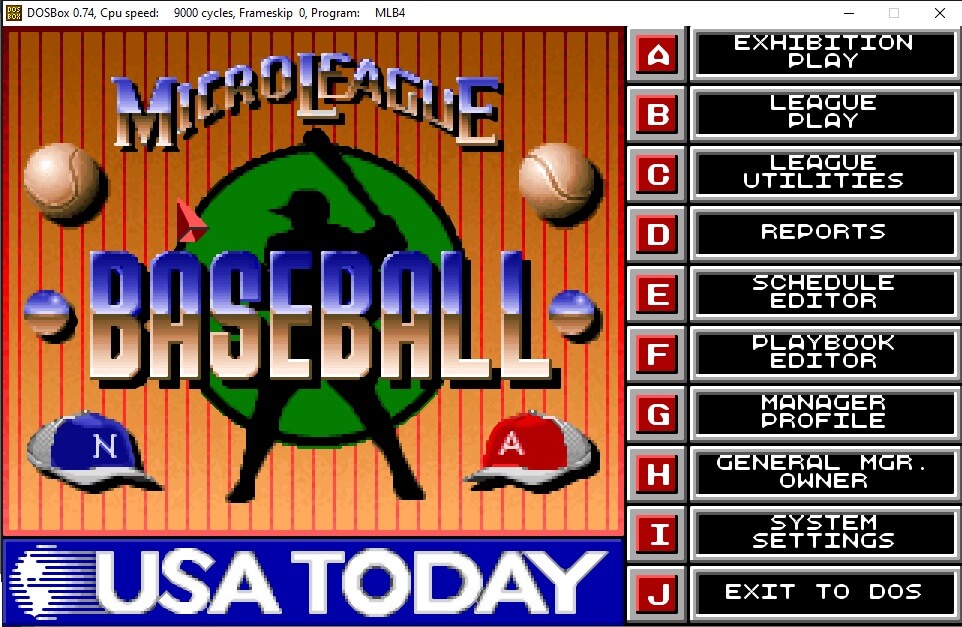
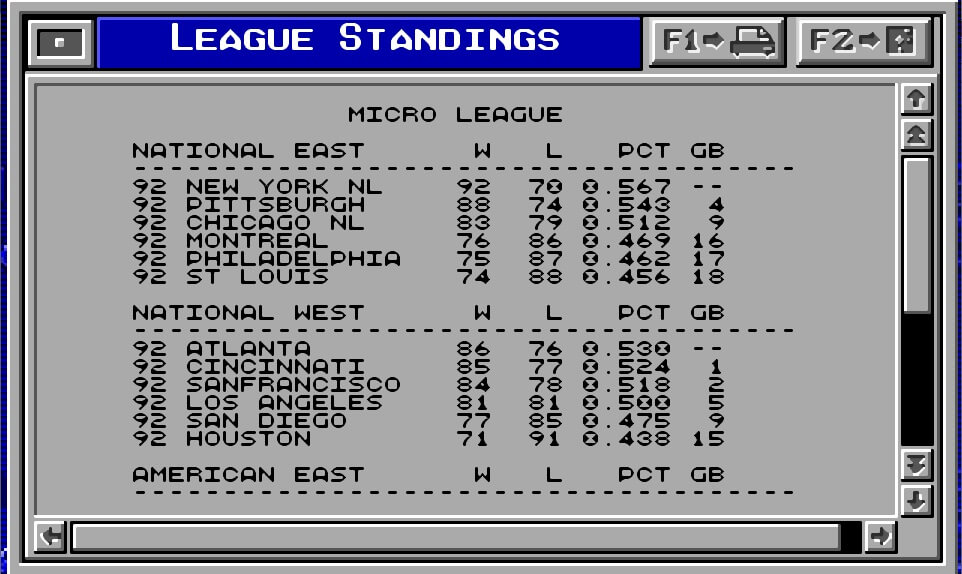
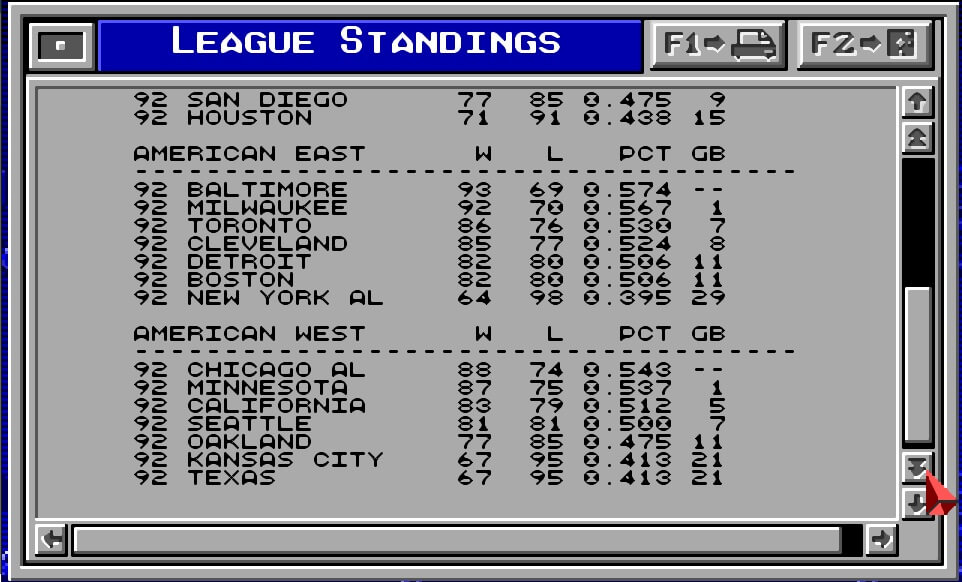
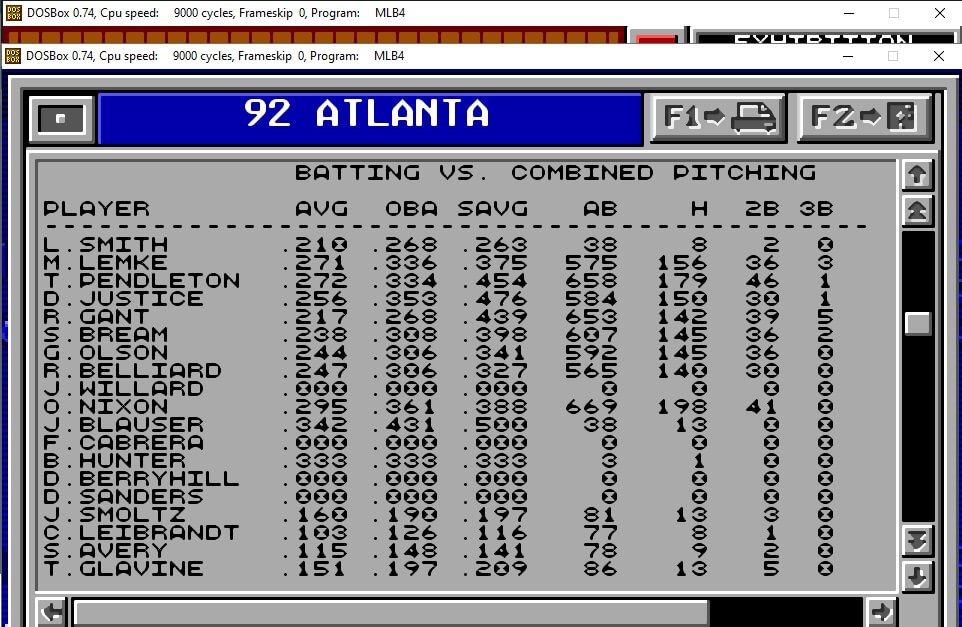

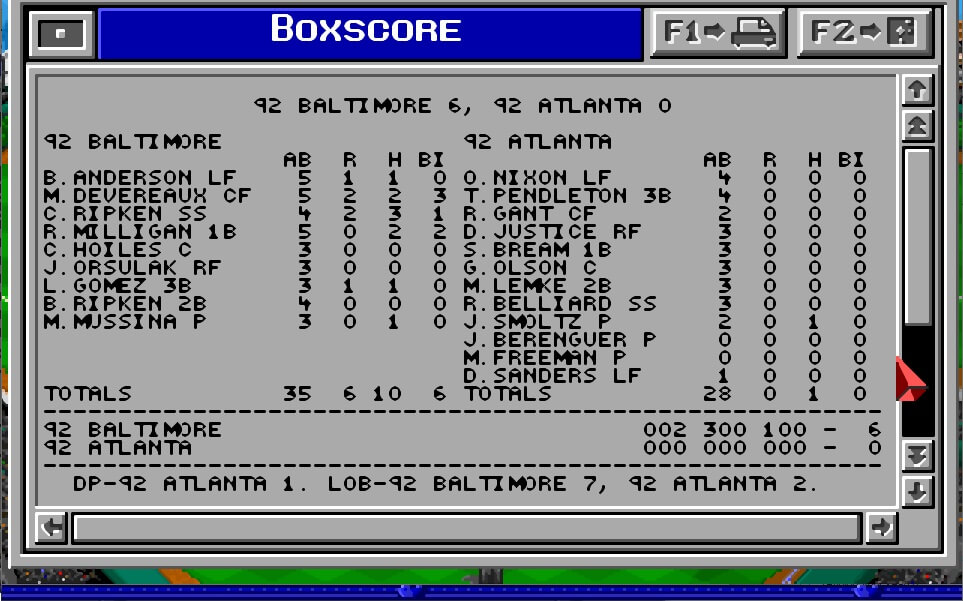

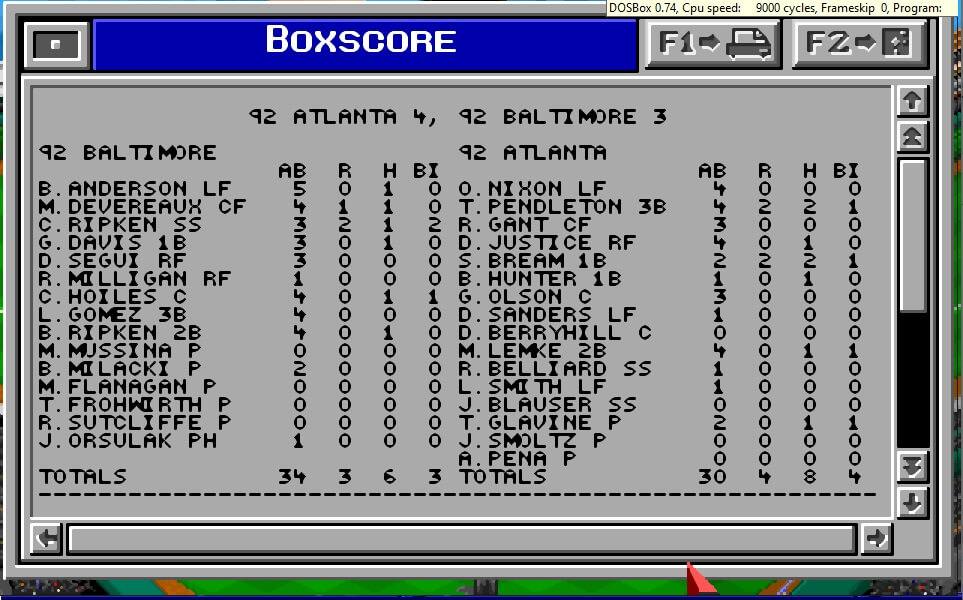
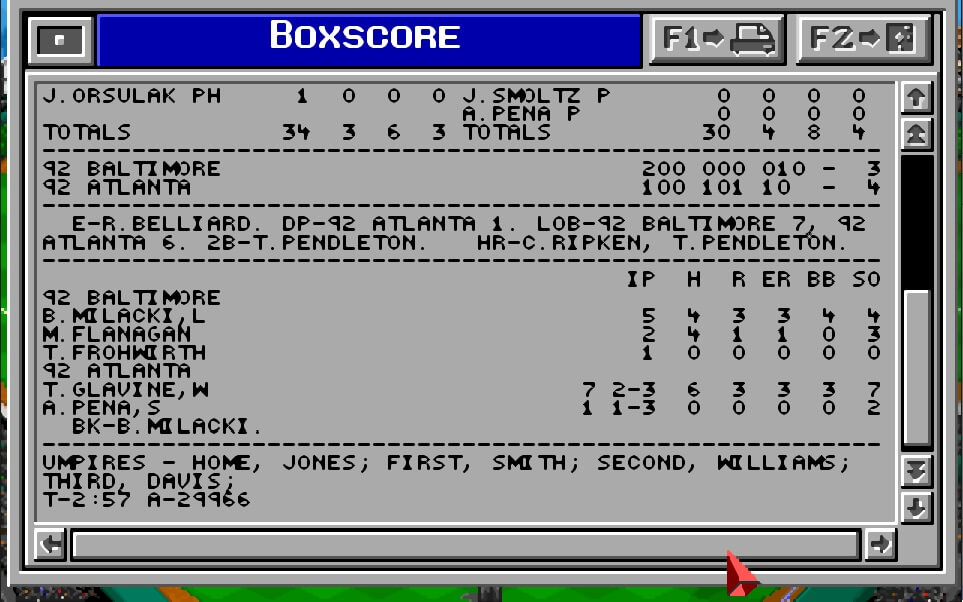
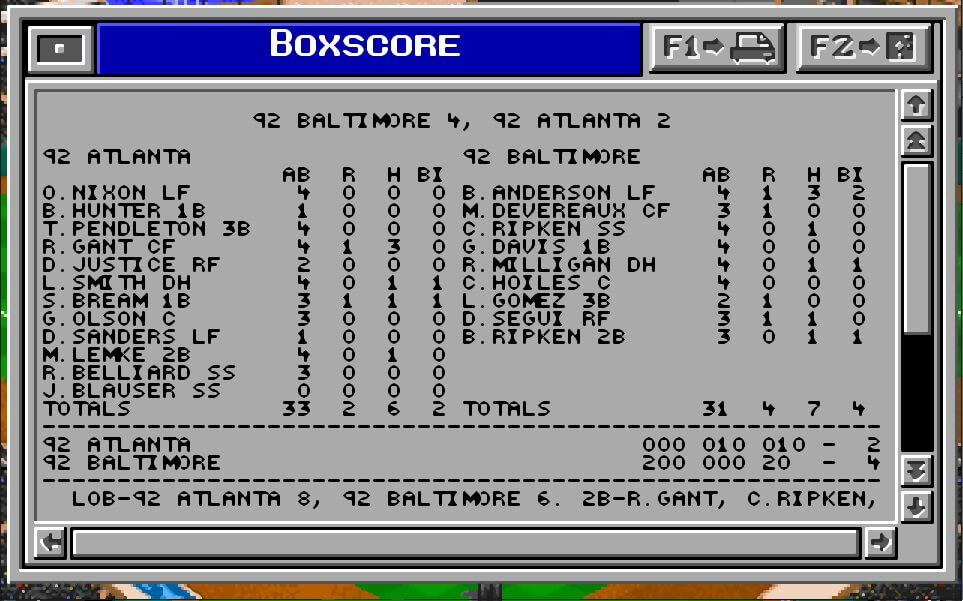
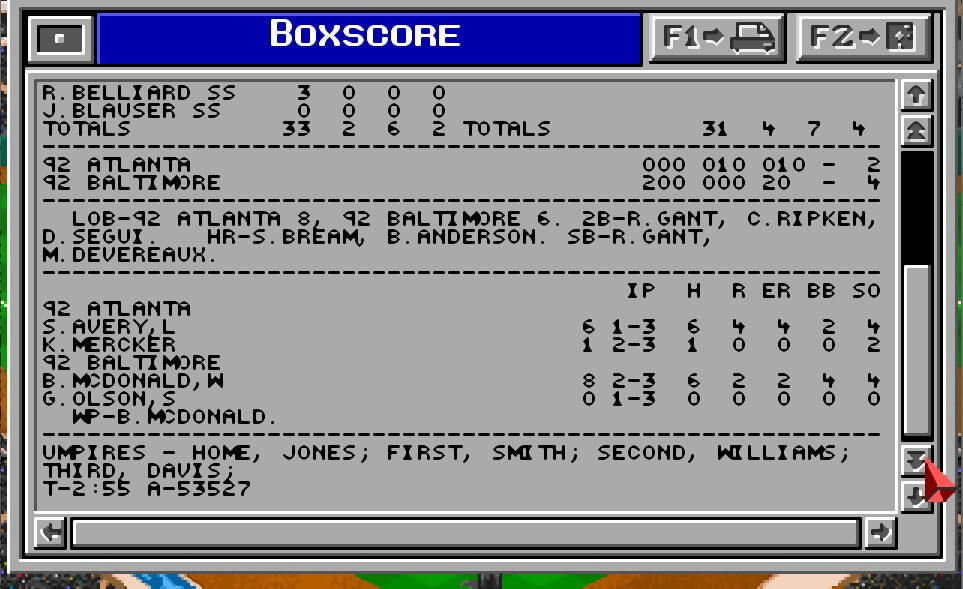
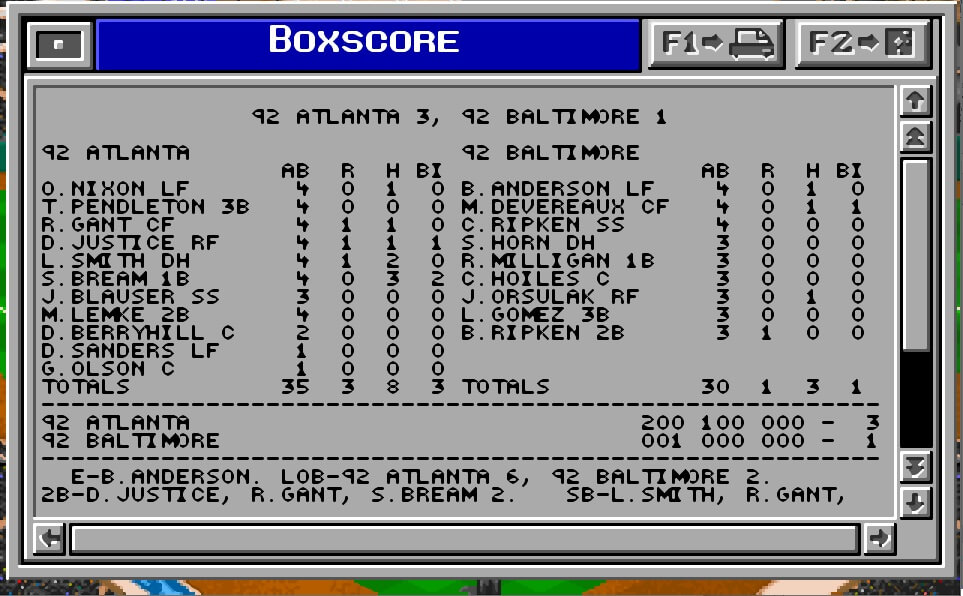
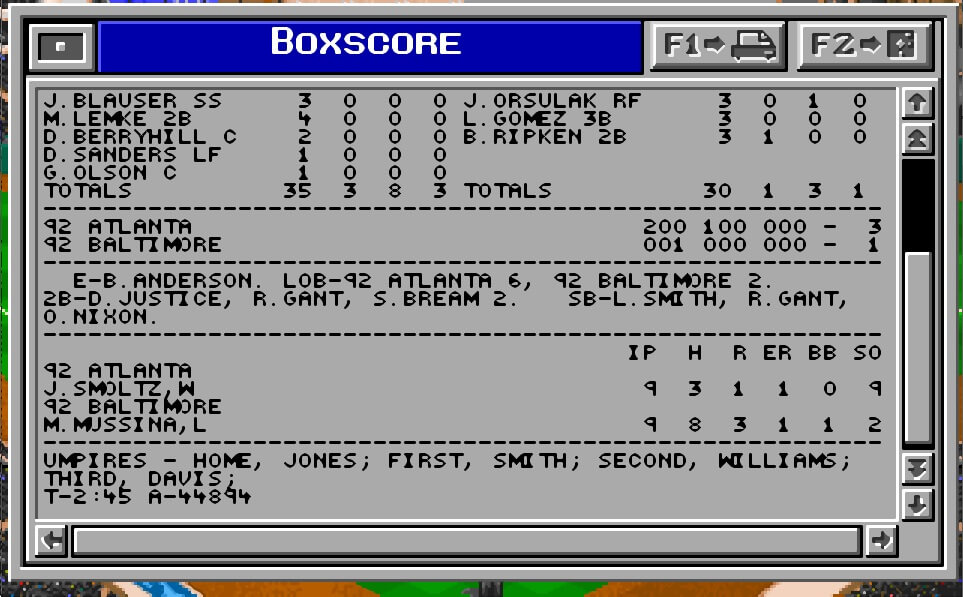
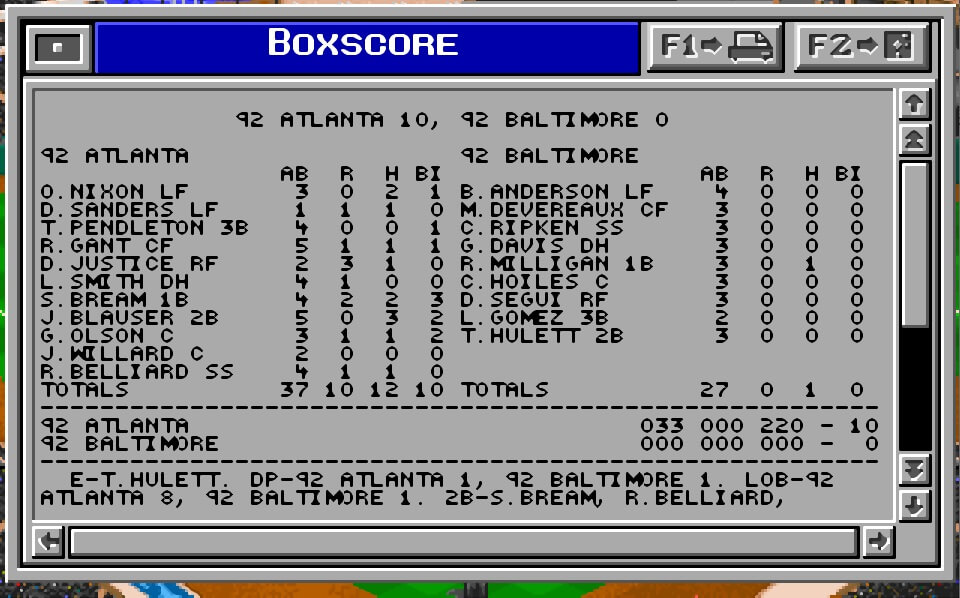
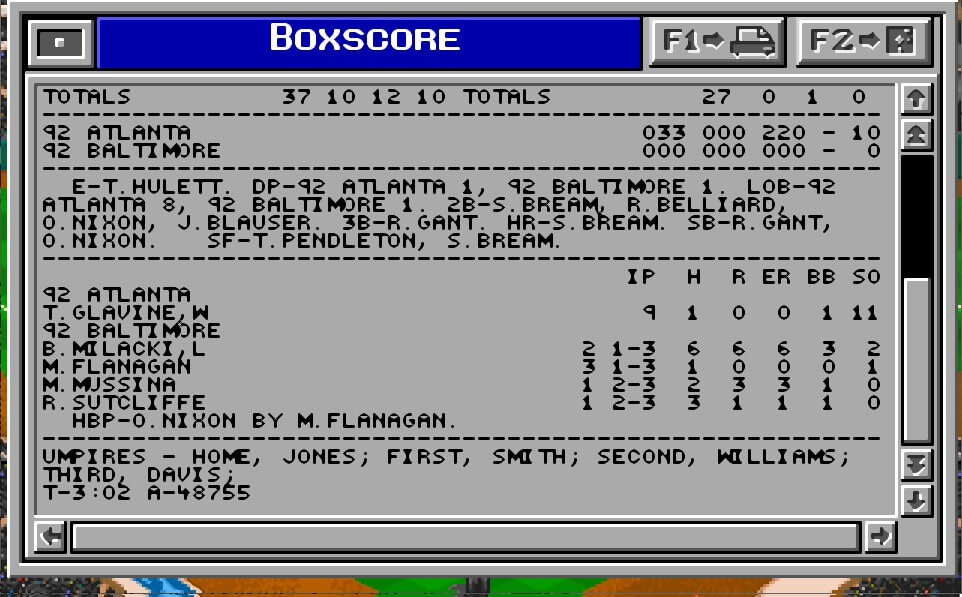
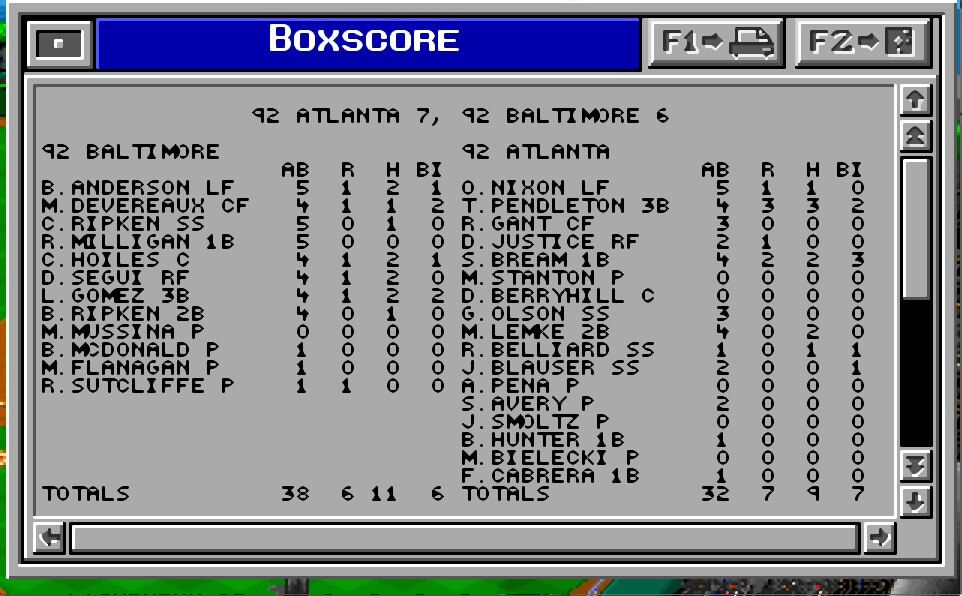
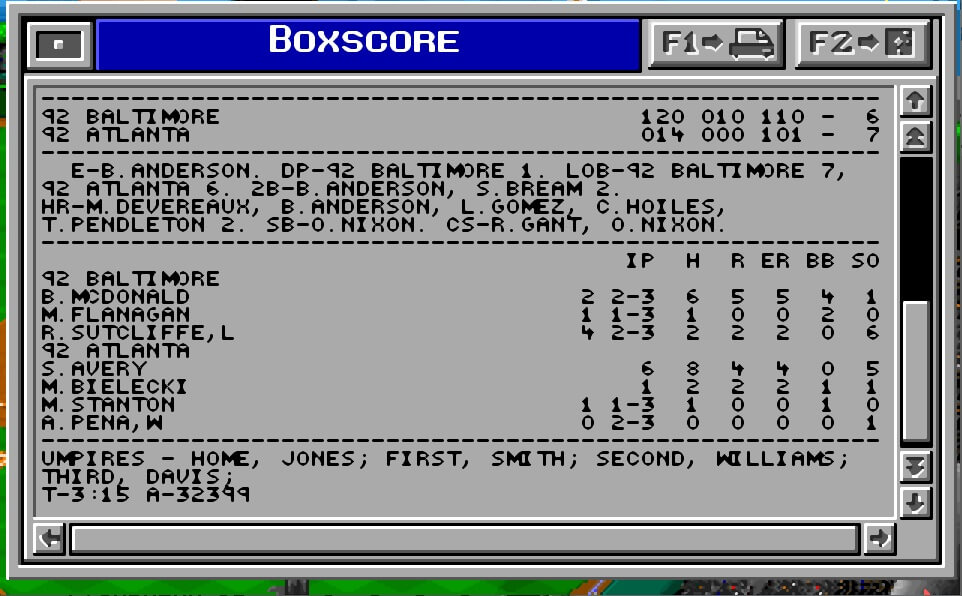
Articles in the Series
Additional Links
Play MicroLeague Baseball II in your browser! –
https://archive.org/details/msdos_MicroLeague_Baseball_2_1989
Play MicroLeague Baseball: The Manager’s Challenge in your browser! –
https://archive.org/details/msdos_MicroLeague_Baseball_-_The_Managers_Challenge_1991
Play MicroLeague Baseball IV in your browser! –
https://archive.org/details/msdos_MicroLeague_Baseball_IV_1992
Playthrough – HardballRetro
“Microleague Baseball: The Manager’s Challenge.” Amiga World, June 1992, p96.
https://archive.org/details/amiga-world-1992-06/page/n97/mode/1up
“Microleague Baseball II.” Compute! Issue 115, December 1989, p126, 130.
https://archive.org/details/1989-12-compute-magazine/page/n127/mode/1up
Microleague Baseball II manual –
MicroLeague Baseball: The Manager’s Challenge manual – https://www.old-games.com/getfile/7581
Microleague Baseball IV manual – https://www.old-games.com/getfile/7579
https://www.mobygames.com/game/microleague-baseball-ii
https://www.mobygames.com/game/microleague-baseball-the-managers-challenge
https://www.mobygames.com/game/microleague-baseball-iv
http://www.stadium64.com/gameinfos/microleaguebaseball2/microleaguebaseball2.htm
https://www.youtube.com/watch?v=f9tPkIfJJ_0 (MicroLeague Baseball II for the IBM PC,
video by Squakenet)
https://www.youtube.com/watch?v=tMrEuqPmZpI (MicroLeague Baseball: The Manager’s Challenge for the IBM PC, video by Squakenet)
https://www.youtube.com/watch?v=eOIA4aUfrfc (MicroLeague Baseball IV for the IBM PC,
video by Squakenet)
About the Author
I am a New Jersey native with a passion for baseball, statistics, computers and video games who enjoys spending quality time with his family.
“Hardball Architects – Volume 1 (American League)“, published in July 2020 and
“Hardball Architects – Volume 2 (National League)”, published in April 2022, examine the trades, free agent acquisitions, draft picks and other transactions for the 30 Major League Baseball franchises, divided into a 2-volume set. Both books are available in paperback and digital (Kindle) format at Amazon.com. All key moves are scrutinized for every team and Sabermetric principles are applied to the roster construction throughout the lifetime of the organization to encapsulate the hits and misses by front office executives. Team performances are analyzed based on transaction type with graphs depicting the WAR (Wins Above Replacement) in every decade. Individual results for each player-transaction is charted over the duration of their stint with the franchise. Every team chapter includes All-Time Rosters and Single-Season Leaders based on transaction type. The Team Trade Record chronicles the WAR and WS (Win Shares) accumulated by players acquired in comparison to those traded to opposing teams. The opening chapter is devoted to the Evolution of the General Manager and incorporates a discussion with former Dodgers GM Fred Claire (along with former Angels and Red Sox GM Mike Port and current Reds GM Nick Krall in Volume 2) on a variety of front office topics.
“Hardball Retroactive”, published in June 2018, is available in paperback and digital (Kindle) format at Amazon.com. Hardball Retroactive is a modest collection of selected articles that I have written for Seamheads.com along with my Baseball Analytics blog since 2010. Exclusive content includes the chapter on “Minors vs. Majors” which assesses every franchise’s minor league successes and failures in relation to their major league operations.
“Hardball Retrospective” is available in paperback and digital (Kindle) format at Amazon.com. Supplemental Statistics, Charts and Graphs along with a discussion forum are offered at TuataraSoftware.com. In Hardball Retrospective, I placed every ballplayer in the modern era (from 1901-present) on their original teams. Using a variety of advanced statistics and methods, I generated revised standings for each season based entirely on the performance of each team’s “original” players. I discuss every team’s “original” players and seasons at length along with organizational performance with respect to the Amateur Draft (or First-Year Player Draft), amateur free agent signings and other methods of player acquisition. Season standings, WAR and Win Shares totals for the “original” teams are compared against the real-time or “actual” team results to assess each franchise’s scouting, development and general management skills.
Don Daglow (Intellivision World Series Major League Baseball, Earl Weaver Baseball, Tony LaRussa Baseball) contributed the foreword for Hardball Retrospective. The foreword and preview of my book are accessible here.
“Hardball Retrospective – Addendum 2014 to 2016” supplements my research for Hardball Retrospective, providing retroactive standings based on Wins Above Replacement (WAR) and Win Shares (WS) for each “original” team over the past three seasons (2014-2016). Team totals from 2010 – 2013 are included for reference purposes. “Addendum” is available in paperback and digital (Kindle) format at Amazon.com.
NOTE: Original article posted on the Hardball Retro website, February 29, 2020.
